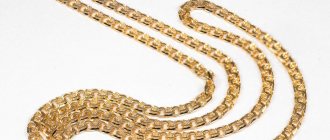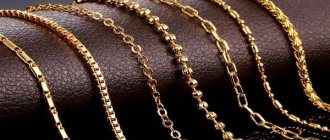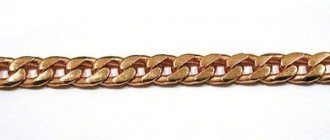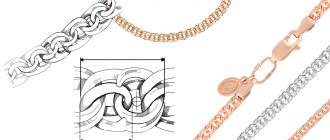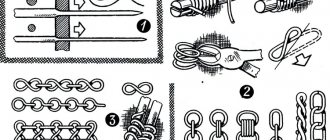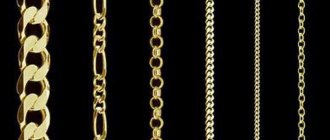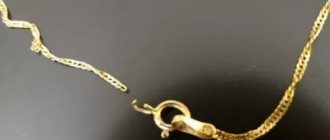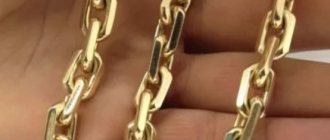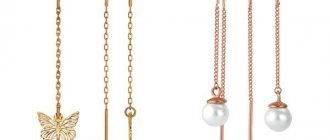Can a chain itself serve as an exquisite piece of jewelry? A hundred times yes, especially if it is made using some interesting technique. Today our focus is on Byzantium, or more precisely, on chains made using the same technique.
As a result of the filigree work of masters, self-sufficient jewelry is obtained, distinguished by incredible aesthetics, a kind of lace frozen in metal. Any pendant on them will look excessive.
Weaving a chain of gold Fox tail (a variety of Byzantium) is very difficult to perform - only experienced jewelers undertake it. Yes, such masterpieces are not cheap, but the exclusive cannot be cheap. And in this case we are talking about exactly that – the standard of high taste and an indicator of the corresponding status!
If you are choosing a chain as a “backdrop” for a pendant, it is wise to choose some kind of laconic weaving - anchor, chain mail, geometric Venetian.
The history of the discovery of such technology
The history of the technology is interesting. According to experts, it goes back to the distant Bronze Age. Some of the first samples were found at royal graves in the city of Ur, which is located in the Middle East. However, it was never possible to reliably find out where exactly the weaving itself came from. Some historians suggest that it appeared in Byzantium (this hypothesis gave one of its names).
Another part of the researchers is inclined to believe that the invention belongs to the masters of Ancient Greece and Rome.
This jewelry technology quickly gained popularity and spread widely throughout Europe, soon coming to Russia. Even now, a large number of jewelers from all over the world use Fox Tail to obtain various copies of ancient jewelry from ancient times, to make something new and unique, and also to decorate their original works. A large number of private craftsmen in Moscow make amazing products and jewelry based precisely on this technique, trying to make something new and original.
History of appearance
The manufacture of products made using this “link-to-link” joining method began in the Bronze Age. The first examples of chains were found during excavations of royal graves in the city of Ur in what is now the Middle East.
However, it is impossible to reliably determine where the foxtail weave comes from. Many attribute its appearance to the merits of Byzantine jewelers, which is fundamentally incorrect, but quite understandable: in the 7th century, this technology was improved by Greek and Roman craftsmen. They created methods for connecting several rows of links into one strip. As a result, fox tail weaving has become widespread in European countries and Russia.
Today, craftsmen resort to using it to produce copies of antique jewelry, create independent products, and also as an additional element in original work.
Fox tail or Byzantine decorative chain
Continuing the religious theme, the jewelers diluted individual elements of the fox tail weaving with round links, making such weaving massive, almost without gaps, and eternal. The decorative Byzantine chain can withstand the most massive pendants and crosses. With an average chain length, its weight will be over 130 grams. The shortened version of the chain allows it to be worn as an independent decoration for a woman, a Byzantine necklace.
A thinner version of the chain can be made by our master jewelers especially for women with a mix of fox tail and knot weaving or, as it is also called, walnut. The Roman decorative gold chain was created as an independent decoration of exclusive design for women.
Unrivaled in popularity when creating masterpiece chains, Byzantine weaving links are used as a decorative element in themselves. The connecting links of the Byzantine figure eight chain are the details that embody the sign of infinity, each of which is created by hand by a master. The special charm of the chain is given by the use of gold of different colors, for example red and white, eliminating the need to select a pendant for a chain of a specific color. A medium-length chain weighs just over 20 grams.
Gold chains with Byzantine weaving
To make massive gold chains, the Fox Tail twist is most often used. With the help of this knitting, links of the same size and shape are connected in a fantasy plexus. It is this type of fastening that allows you to give the product a unique shine in the sun.
The photo of a gold chain with “Byzantine” weaving shows that this jewelry is particularly durable and dense, regal in beauty and sophistication.
Products in the Fox Tail style are more common among men. Chains with this knit look great in any gold color, so you can wear them with whatever outfit you want.
If a representative of the female half of humanity wants to buy herself a piece of jewelry with a “Byzantine” twist, then it is better for her to opt for its “Spikelet” variety.
This knitting is very similar to the “Fox Tail”, but in the pattern of such products the links point in one direction.
This type of weaving of gold chains, as in the photo, looks like a spike of wheat:
By the way, jewelry with this pattern is very popular in Great Britain.
In addition, products in the Spikelet style are very durable and can be worn daily. It takes a lot of effort to confuse such a chain!
Weaving a chain Fox tail: gold and silver chains with Byzantine weaving
Can a chain itself serve as an exquisite piece of jewelry? A hundred times yes, especially if it is made using some interesting technique. Today our focus is on Byzantium, or more precisely, on chains made using the same technique.
As a result of the filigree work of masters, self-sufficient jewelry is obtained, distinguished by incredible aesthetics, a kind of lace frozen in metal. Any pendant on them will look excessive.
Weaving a chain of gold Fox tail (a variety of Byzantium) is very difficult to perform - only experienced jewelers undertake it. Yes, such masterpieces are not cheap, but the exclusive cannot be cheap. And in this case we are talking about exactly that – the standard of high taste and an indicator of the corresponding status!
If you are choosing a chain as a “backdrop” for a pendant, it is wise to choose some kind of laconic weaving - anchor, chain mail, geometric Venetian.
Why are copyrighted works so expensive?
People who are not familiar with all the features of jewelry are often worried about the question: why is the price of products made using the Fox Tail technique so high? The answer is simple:
• painstaking work takes a lot of time to assemble all the elements into one pattern; • parts can only be connected manually;
• you should first prepare a huge number of parts from which the decoration will be assembled.
In addition, even a short chain 50 cm long requires at least 30 grams of precious metal.
Kinds
Thanks to the processing of links, craftsmen achieve various effects that add originality to the product when creating jewelry using the “fox tail” technique. Weaving a chain or bracelet has several possible types, differing in the shape of the elements:
- The assembled “fox tail” consists of spirals twisted in different directions. Each link is assembled from six thin rings, connected by hand with wire, which allows you to create a unique pattern. The cost of such a product will be extremely high.
- The circle is a variety famous for its durability. Thanks to the uniform distribution of internal ligaments, the rounded spirals of the links cannot be torn apart.
- Semicircular weaving has a smaller bend radius of the element.
- The latter type has a square cross-section and is composed of rings, wires and link links, making it ideal for creating chunky chains and bracelets.
Moreover, such a chain (weaving “fox tail” in any of the modifications listed above) has good density, which allows you to put additional pendants on it. Their number is not limited, but they must have a mass less than the total weight of the product.
Types of hand and machine weaving of gold chains around the neck
Using stamping, craftsmen make such types of gold chains as, for example, anchor and “Love”. These chains are made from specially prepared links - stamps. The parts are not soldered together, but threaded into each other. Such jewelry is not very durable, gets very twisted and is easily deformed.
The manual type of work is characterized by the production of the most expensive types of weaving gold chains for women and men. It takes a lot of time to produce one piece of jewelry, because the craftsman does without any automatic tools throughout the entire process. The weight of such products is at least 6 g. It is for twisting “Bismarck” and “Fox Tail” - it is also called “Byzantine” - that handmade jewelers are used.
The most common type of making patterns in gold chains is considered to be machine making. From the name it immediately becomes clear that the product is produced using automated equipment. In such cases, craftsmen can work with very small links - up to 0.2 mm. Machine weaving of gold neck chains is much cheaper than hand weaving. Varieties of weaving “Nonna” and “Double Anchor” are produced using machine technology.
It is customary to distinguish three main technologies for twisting chains: “Bismarck”, “Anchor” and “Pantsirnaya”. However, over the years, these varieties have received many variations. Now there are about 50 types of them: from the simplest to chains with intricate links. The names of weaving chains made of gold are very unusual, but this does not make the jewelry look any less attractive.
Chain weaving technologies
Chains are made in several ways - by hand, machine knitting or stamping.
Machine weaving is an automated technology using special equipment. The use of machines allows you to create jewelry with links up to 0.2 mm thick.
Despite the latest technologies, some types of weaving can only be done by hand. And here you can’t do without specialists—chain tyers. The minimum weight of a hand-woven chain is about 6 grams, and its quality largely depends on the skill of the jeweler.
This is really painstaking and time-consuming work. First you need to stretch the gold or silver wire, wind it on the prepared base and cut the resulting spiral into rings of the same size. The chain maker manually fastens the links using pliers, “linking” the pattern, which involves the type of weaving. To prevent the rings from falling apart, all the links are soldered. The resulting chain is clamped between special shafts so that the links become flat.
Stamped chains are made from ready-made links - stamps. At the same time, they are not soldered together, but threaded into each other. As a rule, such jewelry is less durable, easily twisted and deformed.
Benefits of weaving
The main advantage of this jewelry making technique is the variability of the materials used. Weaving “fox tail” (gold, silver or brass - it doesn’t matter at all) always looks advantageous and elegant. Note that the most popular are chains and bracelets made of precious alloys, which affects the already high cost of handmade items.
Also, this type of weaving has high strength and reliability during operation, since the complex system of connecting links does not allow the product to be torn with bare hands, and its universal appearance makes it possible to wear the jewelry every day without removing it.
Simple weaving
Anchor . Let's start with the simplest type of chain weaving . With this type of weaving, one link is in a perpendicular plane to the other link. These links come in round and elongated shapes. Here is an example of an anchor weave chain with elongated links:
Double anchor chain:
Anchor rollo , and this weaving is characterized by the round shape of the links.
This is an anchor weave made of flat links:
Sea chain . Another interesting type of anchor chains. It looks like a real ship's anchor chain and its links have jumpers in the middle. Anchor chains are durable and unpretentious. They are easy to clean since they do not have complex woven links. When purchasing such a chain, you need to pay attention to the lock; when you look at it, you should have confidence in its reliability.
Paper clip or bird's eye . Interesting and beautiful weaving, also durable and practical. Hollow chains with this type of weaving are often found. I am always against blown or hollow products, but this type of chain, even in the blown version, lasts for quite a long time, although we must not forget about care when wearing it, since deformation of the metal is possible:
Cartier . The following type of chains is named after the legendary brand:
Shell or Tape weaving . Simple classical chains are characterized by the links being in the same plane. Here is an example of a classic weave with a diamond edge:
Rhombo single weave . The next type of weaving is very durable and popular, especially among the male population. Here is an example of a faceted diamond:
Double diamond:
Triple diamond:
Nonna . Similar in weaving to rhombus, they are also very reliable, but more feminine:
Bismarck (Cardinal) . Another group of chains that are popular, especially in Russia (the favorite chains of brothers), has a huge number of varieties:
Double Bismarck.
And this weaving is called triple bismarck.
Bismarck weaving with balls.
Abinata is also a type of Bismarck weave.
Rose is a voluminous and very beautiful type of chain weaving :
Italian (python) , the weaving is very beautiful and durable connection of precious metal links:
Turtle . The next beautiful option for chains and bracelets, however, again based on my practice, I can say the following: the chain itself is strong, but these plates, reminiscent of a tortoise shell, very often cling to clothing, spoil its appearance, and even worse, they come off and will have to take it to the workshop and pay money for repairs.
If you nevertheless decide to buy this type of weaving, then I advise you not to buy a thin or light product with such a pattern, buy something heavier and, accordingly, stronger, so that you do not have to run around jewelry workshops in search of high-quality repairs.
Manufacturing technique
“Fox tail” is woven only by hand: there are no machines capable of making a chain using this technique yet. Weaving requires great skill from the jeweler and is considered one of the most difficult. To accomplish this, links of different shapes are connected in series:
The thickness of the links determines the width of the future chain or bracelet.
The process of weaving a “Fox Tail” is labor-intensive and painstaking. The master uses special curved thin-nose pliers without notches, carefully connecting the elements together. The work takes a lot of time and requires maximum concentration on the process.
Both hollow and solid metal wire can be used to make a chain. In the first case, you will get a “blown” chain, in the second - a cast one.
Advantages and disadvantages
“Fox tail” is valued for the following qualities:
- strength - it is almost impossible to accidentally break the chain;
- flexibility - weaving from small links can be bent at different angles without fear of creases;
- aesthetics - the decoration looks unusual and bright both with and without a pendant.
The disadvantage of weaving is that it turns out to be quite heavy. The average weight of a chain 50 cm long is 25 grams. Because of this, as well as exclusively handmade work, the cost of the product will be quite high.
“Fox tail” is difficult to clean: dust and dirt quickly gets clogged into the winding structure of the weave. Home cleaning only removes surface stains. After purchasing, you will have to pay additional costs for ultrasonic cleaning 1-2 times a year.
A chain or bracelet made using this technique should be removed at night and during physical activity. It is unlikely that it will be possible to tear a cast product, but it is quite possible to catch it on a protruding edge and deform it. In addition, the volumetric chain will interfere with complete relaxation.
Where is it used?
“Fox tail” is often used to create women's jewelry. Its ornate structure looks great in yellow, red and white gold. A silver chain or bracelet with blackening looks interesting: after processing, the pattern seems more voluminous and expressive.
Products made using the Fox Tail technique are suitable as holiday decorations. They can be combined with a formal or evening outfit. The self-sufficiency of the decoration allows you to abandon other accessories, making the “Fox Tail” the main detail of the image.
Characteristic features of Fox tail weaving
Byzantine weaving is a very complex technique. It has characteristic features of both anchor and shell weaving, but, in essence, is an independent technique. Weaving is done link by link, but several links are located nearby, and in several planes.
Byzantium (Fox Tail, Byzantina, Roman Chain, Royal Bismarck) is woven exclusively by hand - such “smart” machines have not yet been invented. The jeweler arms himself with special thin-nose pliers, calls on all his experience and patience to help, and creates magic!
The result is luxurious, voluminous chains of very dense weaving. Moreover, the location and shape of the links can be very diverse - this is how fantasy weaving and exclusive jewelry are born.
Byzantine chains are very luxurious and solid. They are chosen mainly for men, as well as ladies of an elegant age - for young girls Byzantium is somewhat heavy. But there are exceptions: with an evening dress (for example, the notorious Chanel “little black”) such a chain will look great on any representative of the fair sex.
As mentioned above, weaving the Fox Tail chain is one of the many varieties of Byzantine weaving. Its characteristic feature is the direction of the links in one direction: they diverge at an angle, forming something like a fox tail.
The fox tail is less cumbersome and pretentious than the classical Byzantium. It is less demanding on bows: chains made using this technique can be combined with everyday women's and men's wardrobe, and, if desired, decorated with pendants carefully selected to match the style.
This technique has distinctive characteristics. It must be said right away that the Fox tail and “Byzantine” weaving types are not exactly the same thing. The first is a variation of the second. In general, the “Byzantine” is characterized by a tight connection of several rings in one row (chain mail weaving), however, only for the “fox tail” it is necessary that all the rings be directed in one direction.
If the “Byzantine” weaving can look heavy and massive due to the protruding rings, then the “fox tail” is distinguished by its subtlety and grace.
The peculiarity of chains of this type is the dense arrangement of links, in which there are practically no gaps. This is what makes the products look massive and dense. However, despite the tightly spaced links, this weaving is quite flexible.
The appearance of the finished chain depends not only on the location of the links, but also on their shape. For foxtails, square links are more often used, which can be easily laid in one direction without protruding or standing out.
Durable weaves
Spike , durable and beautiful weaving:
The ear can also look like this:
There are also a large number of chains in which the links are not woven, but are made by casting. After pouring, they are connected by rings into one chain. Here is an example of such a chain:
Solid or hollow: what's the difference?
All chains, regardless of the type of weaving, are divided into solid and hollow.
A distinctive feature of hollow chains is the combination of volume and lightness. The wire from which the decoration is woven is hollow inside, so despite the external thickness of the links, hollow chains have little weight. Most often they are made using complex decorative types of weaving and look quite solid. The advantage of such chains is their affordable price, which is determined by the weight of the product.
Solid chains are much heavier than hollow ones, which affects the cost of the jewelry. However, they are very comfortable for everyday wear, resistant to deformation and external influences and therefore durable. If the links are damaged, a specialist can easily solder the product and restore its original appearance.
Types of chain weaving
There are three basic technologies for knitting chains: “Anchor”, “Pantsirnaya” and “Bismarck”. Over time, they received so many variations that today there are more than 50 types of weaving: from the simplest to the most intricate with links of a complex configuration. Each weave has a special name and can be made in either gold or silver.
It’s easy to guess that “Anchor” weaving got its name due to its resemblance to the weaving of a real anchor chain. It is simple and uncomplicated. In the classic version of weaving, each link has an oval shape.
Links can consist of either one or two “rings”. Therefore, the “Double Anchor” technology is also distinguished.
An "anchor" weave with round shaped links is known as "Rollo". At one time, this type of knitting became popular thanks to the fashion house Chopard, so it has a second name - “Chopard”.
The Garibaldi weave is very similar to Rollo. The links of these chains have a round forked shape. It is believed that the knitting was named in honor of the spouses Giuseppe and Anita Garibaldi - folk heroes of the liberation movement of Italy, who were very friendly and shared each other’s views.
Creation methods
At the moment, manufacturers of jewelry accessories present a large number of chains: short, long, wide, narrow, traditional, decorative, for different genders, gold and silver. Chains are made in different ways:
- manual;
- automatic knitting;
- punching.
Weaving gold chains using a specialized machine is considered an automated technology. The use of machines helps produce jewelry with links up to 0.2 millimeters thick. Despite the fact that automation has come a long way, certain types of chain weaving can only be done by hand. And this cannot be done without professional craftsmen. The smallest weight of a hand-woven chain is approximately 6 grams, and its quality largely depends on the jewelry maker. This is actually painstaking and difficult work. Initially, you need to pull out a wire from silver or gold, wind it on a prepared base and cut the resulting spiral into rings of the same size. The chain maker manually makes it stronger using pliers, connecting a pattern that involves a type of weaving. To prevent the rings from diverging, all elements are connected to each other. The prepared chain will be clamped between specialized shafts to make the link flat.
Stamped chains will be made from a finished link. They are not connected to each other, but made together. In general, such accessories are less durable.
Fantasy weaving
Here is an example of a chain with a very rare weave, which belongs to the category of fancy weaves:
And this is the next version of fantasy weaving; the very strong structure of the chain guarantees its durability. A chain of silver rings of the same diameter is assembled:
Another rare type of chain weaving , which in my opinion will always be rare because of its appearance:
Brook . Next view:
Fantasy chains. The most common types:
Royal (Byzantine):
Snail (Lumakina):
Who is recommended to wear
Jewelry workshops most often receive orders for such weaving from representatives of the stronger half. A men's silver Bismarck or Figaro chain, made using this technique, not only completes the look externally, but also adds self-confidence. After all, jewelry is not just a part of the wardrobe, but also, to some extent, a talisman.
Women are recommended to purchase chains and bracelets made using the Fox Tail technique from thinner and more elegant elements.
Masters can offer the following options for original works:
• variable interlacing of silver and gold parts; • gold items made of different shades of metal: lemon, white, red; • distribution of precious and semi-precious stones on the outer part of the jewelry or inside the links.
As you can see, everything depends only on the imagination and skill of the performer and the customer. Remember, original works are always valuable and can be an excellent gift and a profitable investment in the future.
Which weave to choose?
Of course, first of all it is a matter of taste. However, some types of chains are traditionally classified as women's, men's or universal. Thus, the massive and solid “Bismarck” is most often preferred by representatives of the stronger sex, and the graceful “Nonna”, “Singapore”, “Rose”, “Love” and a number of other varieties are considered truly feminine. A typical unisex weaving option is “Anchor”.
For children, the most optimal are densely knitted chains, for example, “Snake”, as well as jewelry cords made of rubber or leather.
In what cases and how to wear the product
Decorating yourself with such a chain will be appropriate and advantageous in the following situations:
- For a young girl going to a special event. A lighter weave, thin and delicate, will look impressive in everyday wear.
- A lady of Balzac's age can easily combine Byzantine chains with clothes in a classical style. In this case, the product will not only perform an aesthetic function, but will also become an indicator of the status and taste of the owner.
- As for the material from which the chain or other jewelry is made, a silver chain of Byzantine weaving would be very appropriate at a meeting with friends, on a date with a young man, at the theater or at a concert. If the event is of a more significant nature, gold chains will emphasize its importance. Byzantine weaving looks great at a wedding or anniversary.
For a man, a chain with a combination of metals and flowers or a gold-plated steel bracelet is suitable. In this case, steel will look no less impressive than jewelry made from precious materials. As for age, Byzantine weaving is always suitable for men, but it is still preferred by men over 35.
The thickness of the chain has a big impact on who and where it is best to wear it. Thus, more massive products will suit older men, or women at formal evenings. A thin chain will highlight your everyday look. A silver chain will fit well into your everyday look, while a gold one is more suitable for evening outings.
In Moscow, they listen to recommendations not to wear Byzantine chains with additional jewelry or decorative elements. Byzantine weaving suggests that the gold or silver chain is a decoration in itself and does not need additional support. Any additional element will make the decoration more simple and ordinary. If, nevertheless, habit or taste requires wearing additional elements, then their mass should not be greater than the mass of the chain itself. This applies to any decoration, regardless of what kind of weaving it is created with.
Advantages and disadvantages
Among the obvious advantages of chains with Byzantine weaving are the following:
- Original aesthetics. The incredibly spectacular appearance of the Byzantine chain immediately attracts attention to the decoration. With its help, you can emphasize the respectable status of a man or create a fantastically stylish female image without any pendants.
- Manifold. An incredible variety of designs, allowing you to create authentic women's jewelry in the style of Ancient Egypt or Greece, emphasize the brutality of truly strong men, realize laconic fantasies in urban outfits - all this is Byzantium!
- Champion durability. It is impossible to accidentally break a chain woven in any variety of the Byzantine style. Why, some chains cannot be broken even intentionally!
Byzantium in general and Fox Tail in particular also have disadvantages, but this is a direct consequence of their undeniable advantages:
- High price. Handmade jewelry cannot be cheap, even if it is made from fairly affordable silver. But any person who is more or less knowledgeable about jewelry will note your excellent taste and probably high (at least visually) social status.
- Poor maintainability. If this chain does break (though it’s hard to imagine what needs to be done with it), you’ll definitely have to go to a jewelry workshop. Not every master will undertake the repair of an exclusive piece of jewelry, and it will not cost a penny.
- Difficult to care for. Byzantine weaving is very dense, there are practically no gaps between the links. This creates serious problems in caring for the jewelry. Even a tangled hair can sometimes be difficult to pull out, but what can we say about more serious care? However, special devices for ultrasonic cleaning of jewelry are available in any workshop.
How are men's chains different from women's?
The difference is quite significant, although some models belong to the “unisex” category. In order not to doubt the product you chose in the store, I recommend remembering the rule. Men's chains can only be short (but not less than 50 cm!) or medium length (that is, they do not fall along the torso), they must be thick (from 7 mm) or medium thickness (from 4-5 mm). There is no enamel or inlay on men's chains.
The most popular among both men and women are thin chains of medium length. This is considered a classic, versatile neck chain option.
Combination of chain with bracelet and pendant
Many of us wear a chain all the time, so we don’t perceive it as decoration. However, we should not forget that this is an accessory that, like any piece of jewelry, requires special combination rules.
The pendant should match the chain in size, weight (about twice as light) and metal color. Thus, a large pendant or cross on a thin chain will look ridiculous, and at the same time, a pendant that is too small will not fit on a massive item.
Be sure to check that the ear of the pendant fits freely through the lock.
In addition to ordinary chains, there are also chain bracelets that are often worn by both women and men. Ideally, the types of weaving of both products should match, but this does not happen often - jewelry can be given as a gift, purchased in different places, or several years apart. Therefore, it is enough that the bracelet and chain match each other in thickness and metal. For example, the “Nonna” chain will look good with a “Rhombus” or “Love” weave bracelet, and the “Bismarck” chain will look good with a wide “Armor” knit.
In any case, if you doubt the compatibility of two decorations, it is better to leave one. As the incomparable Coco Chanel said, “When choosing accessories, take off the last thing you put on.”
Additional accessories
When a man already has a chain that he constantly wears, or wants to make the gift more personal, purchase a pendant. Her choice is based on the style in which the base is made. The pendant can only be worn on thin jewelry. The most suitable weaves are considered to be anchor, armor, diamond and others that do not add width to the product.
You can buy a pendant for a representative of the stronger sex or order it in an online store, taking into account the main trends. Popular pendants are:
- Crosses or incense with religious motifs. They are worn on chains, the length of which allows you to hide the jewelry under a shirt or T-shirt.
- Sports attributes for avid fans: a miniature football or basketball, a hockey stick, a pendant in the shape of skis or skates, etc.
- Amulets with ancient Slavic symbols.
- Pendants with the image of the zodiac sign. A gem that is favorable according to the horoscope is added to them so that the man will have good luck.
- A key made of precious metal as a sign of devotion can be given to the chosen one by a girl in love.
- Skulls and wings are suitable for those who like to drive fast in a personal car or motorcycle.
- The fang of a wild animal will look impressive on a gilded chain. This pendant has a special value because it is made by hand.
- A grenade or dagger will be a good gift for those who served in the army or love military reenactments.
- Engraved metal plates do not lose their relevance.
In order for the gift to be appreciated, you can give a man inexpensive jewelry. It is important to take into account the range of interests of the applicant.

